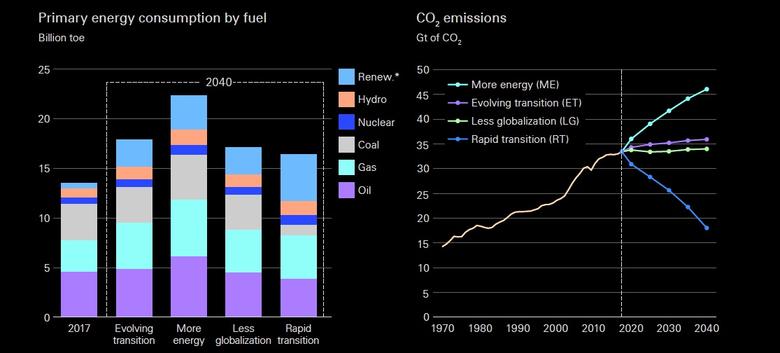
BP: NUCLEAR POWER UP TO 3400 TWH

WNN - BP's 2019 Energy Outlook forecasts an overall rise in nuclear to 2040, to around 3400 TWh. The document is produced to aid the company's analysis and decision-making and is published as a contribution to the wider debate.
The Energy Outlook considers a number of different scenarios, which "explore the possible implications of different judgements and assumptions by considering a series of 'what if' experiments." The scenarios consider only a tiny sub-set of the uncertainty surrounding energy markets out to 2040; they do not provide a comprehensive description of all possible future outcomes. In its 'rapid transition' case, nuclear increases to around 4300 TWh.
Much of the Outlook is described with reference to the 'evolving transition' (ET) scenario, though the "multitude of uncertainties" means the probability of any one of the scenarios materialising exactly as described is negligible, BP says in the report.
Nuclear and hydro power generation continue to grow over the Outlook, although less rapidly than overall power generation, such that their shares within overall power generation decline.
Nuclear power in the ET scenario grows at an average rate of 1.1% p.a., broadly in line with the growth seen over the past 20 years or so.
"The continuing growth in nuclear power disguises two contrasting patterns. Nuclear energy within the OECD declines materially over the Outlook, as aging nuclear plants are decommissioned and there is limited investment in new capacity. In contrast, nuclear generation in China increases strongly, rising by 1000 TWh over the Outlook, with the level of nuclear generation in China by 2040 similar to that in the entire OECD," the report says.
The Energy Outlook explores the forces shaping the global energy transition out to 2040 and the key uncertainties surrounding that transition, BP says. It shows how rising prosperity drives an increase in global energy demand and how that demand will be met over the coming decades through a diverse range of supplies including oil, gas, coal and renewables.
-----
Earlier:

2019, February, 15, 11:55:00
EUROPE'S NUCLEAR SAFETYWNN - The European Union (EU) and the International Atomic Energy Agency (IAEA) have agreed at their seventh annual meeting of senior officials to further enhance cooperation and strengthen cooperation in training, research and development. |

2019, February, 15, 11:50:00
BP ENERGY OUTLOOK 2019BP - The 2019 edition of BP’s Energy Outlook, published today, explores the key uncertainties that could impact the shape of global energy markets out to 2040. The greatest uncertainties over this period involve the need for more energy to support continued global economic growth and rising prosperity, together with the need for a more rapid transition to a lower-carbon future. |

2018, December, 21, 13:45:00
U.S. THERMONUCLEAR PARTICIPATIONWNN - The USA should continue its participation in the International Thermonuclear Experimental Reactor (ITER) project and develop a national research programme towards building a compact pilot plant, according to the National Academies of Sciences, Engineering, and Medicine (NASEM). |

2018, November, 30, 11:15:00
NUCLEAR FOR CLIMATE CHANGESWNN - "We acknowledge the contribution of, and potential for the applications of nuclear science and technology to meet a wide variety of basic socio-economic and human development needs; we recognise the progress made in all Member States in addressing such development needs and the benefits achieved from the application of nuclear techniques in both developing and developed States; and we underscore the growing need and demand for further utilisation of nuclear applications worldwide." |

2018, November, 30, 11:10:00
NUCLEAR POWER FOR CLIMATEWNN - Climate change is the most significant threat to our planet today. The latest Intergovernmental Panel on Climate Change (IPCC) report on the impacts of global warming reaching 1.5 degrees Celsius above pre-industrial levels sends a clear warning that this increase may be exceeded by 2030-2050 unless radical action is taken. Nuclear power is a low-carbon source of energy. According to the IPCC, the median lifecycle emissions from nuclear are 12g/kWh, as low as wind energy. |

2018, November, 14, 11:55:00
NUCLEAR NEEDS INVESTMENTWNN - world electricity generation increases from 25,679 TWh in 2017 to 30,253 TWh in 2025 and to 40,443 TWh in 2040. Global nuclear generation increases from 2637 TWh in 2017 to 3726 TWh in 2040, when it will account for around 9% of total electricity production, down from the current level of about 10.5%. Fossil fuels remain the major source for electricity generation under this scenario, but their share falls from around two-thirds today to under 50% by 2040. |

2018, November, 14, 11:50:00
NUCLEAR POWER CHANGINGWNN - The search for solutions to climate change must include discussion of nuclear power, Scott Foster, director of the Sustainable Energy Division of UNECE, told |










